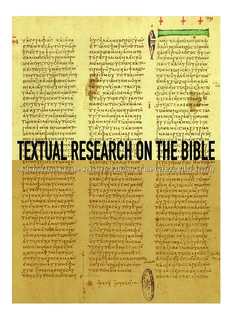
Textual Research on the Bible - Academic Bible PDF
Preview Textual Research on the Bible - Academic Bible
ENG_210x210_4c_32S 23.05.2010 21:58 Uhr Seite 1 ENG_210x210_4c_32S 23.05.2010 21:58 Uhr Seite 2 CodexVaticanus,datingbacktothefourthcentury,isregardedasoneofthemostimportant biblicalmanuscripts.Withtheexceptionofafewlacunae,itcomprisestheentireOldandNewTestaments. AtrightaretheendoftheGospelofLukeandthebeginningoftheGospelofJohn. ENG_210x210_4c_32S 23.05.2010 21:58 Uhr Seite 3 TEXTUAL RESEARCH ON THE BIBLE AnIntroductiontotheScholarlyEditionsoftheGermanBibleSociety What Is Old Testament Textual Research? ..................................................................................................................................................................................................................................................... 4 I. TheBibliaHebraicabyRudolfKittel(BHK)...................................................................................................................................................................................................................................... 9 II. TheBibliaHebraicaStuttgartensia(BHS)............................................................................................................................................................................................................................................. 12 III. TheFutureoftheBibliaHebraica:TheBibliaHebraicaQuinta(BHQ)Project............................................................................................................... 12 What Is New Testament Textual Research? ................................................................................................................................................................................................................................................. 16 I. TheNestle-AlandNovumTestamentumGraeceandItsHistory................................................................................................................................................................ 19 II. TheGreekNewTestamentandItsHistory.......................................................................................................................................................................................................................................... 25 III. TheSignificanceoftheTwoEditionsToday...................................................................................................................................................................................................................................... 28 IV. TheOutlook:NewTestamentTextualResearchContinues.................................................................................................................................................................................. 29 ENG_210x210_4c_32S 23.05.2010 21:58 Uhr Seite 4 What Is Old Testament Textual Research? All reliable translations of the Old Testament (OT, DeadSea.Theseancientmanuscriptsincludethere- frequently called the Hebrew Bible - HB) into any mains of some 200 transcriptions of individual language used today must be based on the ancient books of the Bible from the period between 150 manuscripts that have survived to the present day. B.C. and A.D. 70. Apart from one single transcrip- The important task of determining the Hebrew (most tion of the Book of Isaiah preserved in its entirety, oftheOT)andAramaic(portionsofDaniel,Ezra,and the biblical texts from Qumran are mere fragments, a few other verses) text most faithful to the original on which in most cases a very limited number of le- writings is a complex one because there is no docu- gible words, often only a few characters, can be mentthatdatestoitsbiblicalauthor(theautograph), made out. but only carefully crafted, but not perfect, copies from later periods. Much of the prophetic writings, TheoldestcompletecopyoftheentireHebrewBible for instance, date from the 9th to the 6th centuries as we know it today is the Codex Leningradensis B.C.,buttheveryoldestfragmentsofcopiesinHebrew from the year 1008. Another ancient copy, the andAramiacthatexistcomefromthe2ndcenturyB.C. AleppoCodex,datingfromalmostahundredyears earlier (A.D. 930), is unfortunately no longer com- It was in the 3rd century B.C. that the Hebrew Bible plete. The Codex Leningradensis and the Aleppo was first translated into Greek; this so-called Sep- Codex aretwoprimeexamples of theso-calledMa- tuagint is the oldest and most important indirect wit- soretic text (MT; see below pp. 6-7). ness from that era for the wording of the Hebrew/ Aramaictext.Further ancient translations werelater Old Testament textual research sets out to identify added, above all the translation into the common accidentalerrorsin,aswellasdeliberatechangesto, (“Vulgata”) Latin, the Syrian “Peshitta” and the Ara- thetextoftheHebrewBiblethatweremadeoverthe maic “Targum”. courseoftime.Itseekswhereverpossibletocorrectthese changesbyfirstidentifyingvariationsintransmission TheoldestdirectwitnessesforthetextoftheHebrew through a comparison of the existing manuscripts Bible are the manuscripts found in 1947 and there- against each other and against the ancient transla- after in the Judean Desert that had been hidden in tions,andthenreconstructingtheoriginalversionby caves near Qumran on the western edge of the means of rigorous scholarly criteria. (See the next 4 OldTestamentTextualResearch ENG_210x210_4c_32S 23.05.2010 21:58 Uhr Seite 5 section for the procedure used in New Testament textualresearch.)Onthebasisofmanuscriptevidence alone the best attainable wording of the Hebrew Bibleisasitwasaround200B.C.Becauseofthein- completenatureofthetextwitnessesavailabletous today,thisoldestattainabletextformcannot,however, be reconstructed to the same extent in all cases. In ordertopresentauniformtextinaprintededitionof theHebrewBible,theconstructionofatextformcor- rectedaccordingtoscholarlycriteria(asinthecase of the New Testament) must thus be dispensed with. Rather, it is expedient to print a copy of the “Maso- reticText”andthentolistwherenecessarytheextant textual variants in what is called the critical appara- tusatthefootofeachpage.Alsointhislocationany scholarly suggestions for improvement of the Maso- retic text can be noted. The Biblia Hebraica Stuttgartensia (BHS), the out- come of the findings from more than 100 years of OldTestamenttextualresearch,followsthisprinciple. The BHS is in universal use today and is esteemed CodexLeningradensis.Theillustrationshows amongscholarsfromallChristianandJewishback- oneoftheelaboratelyexecuteddecorativepagesat grounds as a highly reliable edition of the text of theendofthemanuscript.QuotationsfromMasoretic theHebrewBible.Itprovidesthebasisbothfortrain- rulesandbiblicaltextsarewritteningeometrical ing clergy in the original language of the Old Testa- patterns.Atthecenterisanotebythescribe: ment and is the basis of all reputable modern Bible “I,SamuelbenJakob,wroteoutthiscodexand translations. providedpunctuationandMasorah...” nalauthorsasitispossibletoattain.Itisastoryofdis- OldTestamentTextualResearch 5 ENG_210x210_4c_32S 23.05.2010 21:58 Uhr Seite 6 covery. Background: “Masorah” and “Masoretic text” ApeculiarityofthewayinwhichtheHebrewlanguagewas(and,likeArabic,stillis)normallywrittenisthatitiswritten withoutmostvowels.Formorethanathousandyears,theconsonantswerewritten,butthevowelsrequiredforpronunciation hadtobesuppliedbythereader.ThisistrueoftheQumranmanuscripts.This“consonantal”textoftheHebrewBiblehas beenregardedasfixed(nottobechanged)sincethefirstcenturyA.D.andtheJewishpeoplehaveeversinceattachedgreat importancetoitsprecisetransmission.Theproblemremainsthattheconsonantaltextfrequentlyallowsfordifferentpossible pronunciationsandthuspotentiallyalsodifferentmeanings.Knowledgeofthecorrectpronunciationandmeaningtherefore hadtobepasseddownfromgenerationtogenerationtogetherwiththewrittentext.AroundA.D.600,Jewishscholars,the so-calledMasoretes(literally“conveyorsoftradition”)finallydevelopedasystemofvowelandstressmarksthatalso preciselyfixedorestablishedthepronunciationandthusthemeaningoftheHebrewBibletext.TheMasoretesatthesame timeundertooktextualresearchofthehighestquality.Inadditiontoestablishingafixedpronunciationandmeaning,they alsoendeavoredtosecurethebiblicaltextagainstmistakesincopyingand,whereverpossible,tocorrectexistingerrors.To thisend,inthemarginoftheirmanuscriptstheyaddeddetailednotesonwriting(orthographic)variants,statisticalinformation onthefrequencyofparticularwords,andevendirectionsastowheretheyconsideredareadingdifferentfromthetransmitted consonantaltexttobenecessary.ThiscompendiumofmarginalnotesisreferredtoastheMasorahParva(“smallMasorah”). Alongwiththislessercollectionofnotes,theMasoretesalsocompiledlistsofentirepassagesfromthebiblicaltextdistinguished, forexample,byacharacteristicorthographicvariant,aparticularsequenceofwordsorotherpeculiarity.Theselists,collectively referredtoastheMasorahMagna(“largeMasorah”),areincludedatthetopandthefootofthepagesoftheMasoreticmanu- scripts.ThehighlymeticulousworkoftheMasoretesgaverisetothetermforthecarefullycopiedbiblicaltextthattheymade, the“MasoreticText.”Becauseoftheircarefulworkdonebetweenthe6thand8thcenturies,fromthattimeonwardsthere hasbeenalargelyuniformlytransmittedversionoftheHebrewBiblewithonlyminortextualvariations. 6 OldTestamentTextualResearch ENG_210x210_4c_32S 23.05.2010 21:58 Uhr Seite 7 AleppoCodex,fromTiberias,c.930.Onlyaroundtwo-thirdsoftheoriginalcontent arestillextant.ThebiblicaltextwiththeMasoreticvowelsandaccentsiswritten inthreecolumns.BetweenthecolumnsandinthemarginistheMasorahParva, andatthetopandbottomofthepageistheMasorahMagna.Atthefarright, thecustomarycourseofthetextisinterruptedsothataparticularpassage (inthiscaseJosh12:9-24)couldbesetoutinaccordancewiththetransmittedrules. OldTestamentTextualResearch 7 ENG_210x210_4c_32S 23.05.2010 21:58 Uhr Seite 8 RudolfKittel(*1853inEningenu.A.;†1929inLeipzig), PaulKahle(*1875inHohenstein;†1964inBonn),Professor ProfessorofOldTestamentStudiesinLeipzig,initiatedthe ofOrientalStudiesinBonnandOxford,recognizedtheeminent plansforacriticaleditionoftheHebrewBiblein1901. significanceoftheCodexLeningradensisfortextualresearch ThefirsteditionofhisBibliaHebraicaappearedin1906. andpersuadedRudolfKitteltousethisCodexasthetextual basisofthe3rdEditionoftheBibliaHebraica. 8 OldTestamentTextualResearch ENG_210x210_4c_32S 23.05.2010 21:58 Uhr Seite 9 I. The Biblia Hebraica by Rudolf Kittel (BHK) The beginnings: The First Edition of the Biblia Hebraica by Rudolf Kittel (1906) Around1901,theOldTestamentscholarRudolfKittel(1853–1929)fromLeipzigdevelopedaplanforacritical edition of the Hebrew Bible. Kittel’s Biblia Hebraica (BHK) was published in 1906 in two volumes by Verlags- buchhandlung J. C. Hinrichs in Leipzig. As its basis, Kittel chose the Hebrew so-called “Textus receptus”, edited by Jakob ben Chayim. This was a version of the Masoretic Text that Daniel Bomberg had published in Venice in 1524/1525.Throughthecenturiessinceitsfirstpublication,ithadbecomeuniversallyrecognizedasthedefinitive textoftheHebrewBible.KittelprintedthisHebrewtextwithitsvowelandstressmarks,butwithoutthesurrounding Masoreticcommentariesandnotes(theMasorahMagnaandMasorahParva).Atthefootofthepagesheincluded a concise critical apparatus with textual variants from other known Masoretic manuscripts and from the ancient translations (primarily the Greek Septuagint). A milestone: The Third Edition of the Biblia Hebraica by Rudolf Kittel (1937) In1921,WürttembergischeBibelanstalt (WBA) acquiredtherights toKittel’s Biblia Hebraica from thepublisher J.C.Hinrichs.Inadditiontoareprintoftheexistingedition,arevisionofthisworkwasundertakenfrom1925onwards. The“CodexLeningradensis”fromA.D.1008hadbeendiscoveredbyPaulKahleinLeningrad,Russia,andbecauseit wastheoldestmanuscriptoftheMasoreticTextpreservedinitsentirety,itsubsequentlyservedasthetextualbasisfor thisedition.Thecriticalapparatuswasdividedintotwoportions;“slightvariantsandlessimportantitemsofinformation” and“therealtextualchangesandothermoresignificantmatter.”Inthiswaythereaderwasprovidedwithanevaluation ofthesignificanceofthatinformation.Aboveall,however,themarginsofthisthirdeditionincludedtheMasorahParva fromtheCodexLeningradensis,althoughwithoutfurthertreatmentorexplanation.Thecompleterevisionwaspublished byWBAin1937asthethirdeditionofKittel’sBibliaHebraica(BHK3).Thispublicationlaidthefoundationforthehigh internationalesteemenjoyedbyBibliaHebraicaandpreparedthegroundforthelaterBHS. OldTestamentTextualResearch 9 ENG_210x210_4c_32S 23.05.2010 21:58 Uhr Seite 10 ThecavesofQumran, onthenorthwestern edgeoftheDeadSea. In1947remainsof manuscriptswerefound herethathadsurvived intheextremelyarid conditionsforaround twothousandyears. CodexLeningradensis,theoldestcompletemanuscriptoftheHebrewBible,fromtheyear1008.Thephotograph showsFolio423withtheendoftheBookofRuthandthebeginningoftheSongofSolomon. 10 OldTestamentTextualResearch
Description: